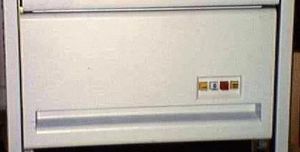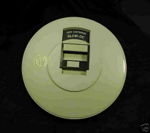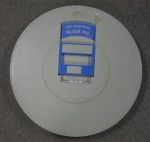RL01/02 disk drive
| RL01 / RL02 | |
| Manufacturer: | Digital Equipment Corporation |
|---|---|
| Drive Controller(s): | RL11 (UNIBUS) |
| Capacity: | 5.2 Mbytes (formatted) (RL01) 10.4 Mbytes (formatted) (RL02) |
| Transfer Rate: | 512 Kbytes/sec 3.9 usec/word (peak) |
| Average Access Time: | 67.5 msec |
| Revolutions per Minute: | 2400 |
| 1/2 Revolution Time: | 12.5 msec |
| One Track Seek Time: | 15 msec |
| Average Seek Time: | 55 msec |
| Maximum Seek Time: | 100 msec |
| Head Switching Time: | 8 msec (maximum) |
| Total Surfaces: | 2 |
| Tracks per Surface: | 256 (RL01) 512 (RL02) |
| Sectors per Track: | 40 |
| Words per Sector: | 128 |
| Tracks per Inch: | 125 (RL01) 250 (RL02) |
| Density: | 3725 bpi (maximum) |
| Recording Method: | Modified Frequency Modulation (MFM) |
| Start Time: | 40 seconds |
| Stop Time: | 30 seconds |
| Physical Size: | 19" W x 10-1/2" H x 25" L |
| Weight: | 55 pounds |
| Power Consumption: | 160W (running); 550 VA (starting) |
The RL01 and RL02 are single platter, removable pack disk drives, introduced in 1976 and 1978 respectively, by DEC. They used an IBM 5440 type pack, as used on the IBM System/3.
The RL01 is a 5MiB drive, and the RL02 is 10MiB; the latter is a high-density version, with twice as many tracks per surface, but otherwise mostly identical.
To keep the heads properly aligned on the tracks, it used a servo system driven by servo data written on the pack (along with sector headers) at the factory. Packs cannnot be low-level re-formatted in the field, and are not compatible with both drive types.
Early versions of the drives included a set of brushes that swing out over the platter on start-up; these were deleted in later versions.
Up to 4 drives may be attached to a single controller; the drives are connected serially. The total length of the string may not exceed 100 feet.
The UNIBUS controller is the RL11, a single hex card. The QBUS controllers are the RLV11 and RLV12; the former consists of two quad cards, and needs a QBUS backplane with CD interconnect; the latter is a single quad card, and is also the Q22 version.
Cabling
The RL0x uses a cable with latching connectors at each end to go between drives; the part number is 70-12122-xx (where xx is the length, one of 08, 10, 20, 40 or 60); it is also known as a BC20J-xx. A later version, with metallic coating on the connector, and thicker double shielded cable is the BC17F-xx (only observed in -10).
To get from the controller to the first drive of the string, one of two setups can be used.
A BC80M-xx cable has a Berg connector at one end which plugs into the controller, and one of the latching connectors to connect to a drive at the other. Alternatively, a BC06R-xx flat cable goes from the controller to a transition adapter in a mounting bracket attached to the rack; a standard cable goes from there to the first drive.
The drive string must be ended with a terminator on the 'out' port of the last drive, part number 70-12293-0-0 (although the terminators generally have no markings on them). Again, terminators in both plain black plastic, and with silvery metallic coating, have been observed.
The terminators for the RL0x and RK06/07 drives are the same, and interchangeable. The cables are semi-compatible; RK06/7 cables may be used with the RL0x, but not the other way around - those for the RK06/07 have additional wires which are not present in the RL0x cables.
4.3 BSD disktab
rb02|RB02|DEC RL02 on 730 IDC:\ :ty=removable:se#256:ns#40:nt#2:nc#32:\ :pa#15884:ba#4096:fa#1024:\ :pb#4480:pc#20480:
Emulating the RL02
Reinhard Heuberger has created an open source emulator for the RL02 (and RL01) using a Terasic DE0-Nano Altera Cyclone IV FPGA board, extended with necessary interfacing hardware and an SD card slot. The emulator can be used with a real PDP-11, for example.
* Home page of project * Picture of the simulator connected to a PDP-11/53



